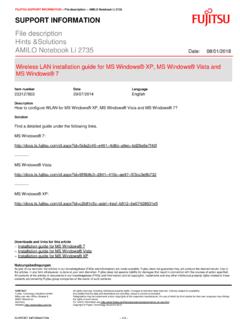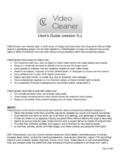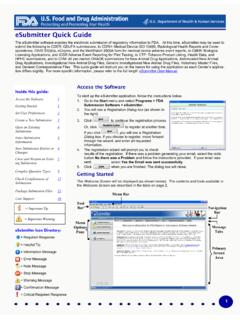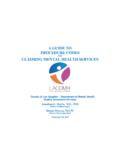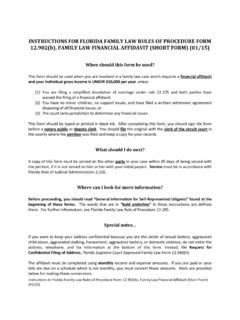Transcription of GCSE ENGLISH LANGUAGE - filestore.aqa.org.uk
1 GCSE ENGLISH LANGUAGER eading resourcePaper 1 Perhaps this was only the first of a whole battalion of crows, that would rise up and swoop at m the King of the Castle Susan HillContentsStory openings:I m the King of the Castle by Susan Hill (1970)Paddy Clarke Ha Ha Ha by Roddy Doyle (1993)Bring up the Bodies by Hilary Mantel (2012)The Reluctant Fundamentalist by Mohsin Hamid (2007)Transition points and endings:Spies by Michael Frayn (2002)The White Tiger by Aravind Adiga (2008)The Thirty-nine Steps by John Buchan (1915)Presenting people, places and action:I m the King of the Castle by Susan Hill (1970)Remarkable Creatures by Tracy Chevalier (2009)Paddy Clarke Ha Ha Ha by Roddy Doyle (1993)The Thirty-nine Steps by John BuchanBirdsong by Sebastian Faulks (1993)Complete short story:Lullaby by Elizabeth Berridge (1947)Texts extracts can be found at the back of resources for GCSE ENGLISH LANGUAGE : Explorations in creative reading for Paper 1 IntroductionStudents will be required to respond to unseen texts drawn from high quality, challenging literature and non fiction on both papers in the final examination, so the two-year course should provide opportunities for them to read widely and become confident in interpreting information and ideas and in understanding the means by which they are objectives for Paper 1AO1: Identify and interpret explicit and implicit information and ideas.
2 Select and synthesise from different : Explain, comment on and analyse how writers use LANGUAGE and structure to achieve effects and influence readers, using relevant subject terminology to support their : Evaluate texts critically and support this with appropriate textual on this paper will be drawn from literary prose fiction from the 20th or 21st addition to developing the relevant skills for the study of literary fiction, teachers may use the following materials to encourage students wider reading. They have been grouped for ease of use, but you will find overlaps between the groups. These suggested reading activities are suitable for both pair and is important for students to start by reading and enjoying the whole passage and then for them to give an independent can be followed by close reading and analysis of the writer s craft.
3 Students can then be asked for a more considered, evaluative response which they need to support with detailed reference and analysis of the words and phrases indicate relevant subject terminology. ENGLISH LANGUAGE READING RESOURCE PAPER 13 Using the material in classStory openingsAims: to understand the ways in which authors use the openings of stories to engage the reader to understand how the conventions of literary genres may be evident in the story opening to understand the structural features of the passage and its place in the structure of the whole novel to make a personal response to the passage with evaluation using inference and m the King of the Castle by Susan Hill (1970) chapter 1 from beginning to But he knew where to find the key. Read the whole passageFirst responsesWhat is the passage about?
4 Which characters does it introduce, and what do we learn about them? What questions does it raise for the reader? What hints does it give about what will follow? What impression is created of the mood and atmosphere at the start of this novel?Close readingLook at the opening sentence and discuss narrative perspective: who is he ? What is this house ? What does this use of pronouns tell us about the narrative viewpoint of the passage?Highlight the words that are spoken aloud, shown by the author s use of direct speech. Reading only these sections, what impression do you have of the characters and their relationships?Now read the sections that present the characters unspoken thoughts. How do these add to the reader s understanding?Much of the direct speech in this passage is reported without any authorial mediation, so the reader must form his/her own response to the characters.
5 What is yours?Identify the terms of address used in the passage. What are the names of the characters? Which nouns and noun phrases are used to refer to them? This is a passage about members of a family: which terms of address are absent that you might expect to have seen? Compare the terms of address/terms of endearment used in your own families. Summarise your understanding of the characters of Edmund and Joseph Hooper, their personalities, emotions and details create an impression of the formality, social status and wealth of the Hooper family? How is the Red Room given a sense of importance and mystery? What does it contain? Why do you think Edmund Hooper wants to go there? What does the final sentence of the passage suggest about Edmund s character and about what will follow?In two columns, list the factual information about the characters and their situation that we are given in the passage, and the inferences that we make based on closer reading this passage, which of the following words and phrases do you think could be used to describe the genre of this novel: comic, psychological, fantasy, mystery, realistic fiction, gothic horror, graphic novel, historical fiction, satire, memoir, science fiction, ghost story?
6 Use details from the passage to support your point of Clarke Ha Ha Ha by Roddy Doyle (1993) from beginning to He never called him Mister O Connell; he called him the Tinker. Read the whole passageFirst responsesWhat is the passage about? Which characters does it introduce, and what do we learn about them? Who is telling the story? What information does it give about the world of the novel? What is the mood and atmosphere of this passage? Did you enjoy it? Did you recognise in it any features of childhood from when you were about ten years old?4 Close readingLook again at the opening paragraph, and discuss what it shows about the narrative perspective of a young boy. Which LANGUAGE details in the whole passage convey the impression of a child s voice? Pay particular attention to the structure ofsentences. Are they generally long or short?
7 What is the proportion of single clause sentences to those that are more multi-clause?What does the style of sentences contribute to our understanding and response?Read the whole passage again, highlighting every point at which there is change of subject or reference to time. Identify examples of non sequiturs. Can you follow the story? How successfully has the author structured it to sound authentically like the account of a child? The narrator of this novel has been described as breathless . Do you agree with this description? Why? Why not? Roddy Doyle is an Irish writer. Identify the details of LANGUAGE that convey an impression of its Irish setting. The narrator is describing very familiar events. Which details show his familiarity with the world that he lives in? How extensive is his world? Our real speech reflects our regional and social identity through accent and dialect.
8 Identify the dialect features of the LANGUAGE used in this passage and explain how successfully you think they create an authentic novel was written for adults, not children, and yet it recounts the life and activities of a ten year old boy. What do you think makes it appealing for an adult audience? In this opening passage there is a mixture of children s play and hints of more serious matters. Identify the more serious issues that Paddy Clarke mentions but doesn t explore. What effect has the author achieved by presenting them in this way? A critic described the novel as Truthful, hilarious, painfully sad . From what you have read so far can you predict how the novel will unfold?Bring up the Bodiesby Hilary Mantel (2012) from the beginning to Teasing him, they amble towards supper. Read the whole passageFirst responsesWhat is happening in this passage?
9 Is it set in the present day or at another time? Look at the clues given by the names of the characters. What sporting or leisure activity are the men engaged in? Would you describe the mood and atmosphere of the scene as relaxed or tense? Troubled or happy? Stormy or calm? What do we learn from this opening passage about the life, work and personality of the main character, Thomas Cromwell?Close readingWhat is the effect of the opening sentence? What does it mean? How does the rest of the first paragraph help you to understand what is happening? Why do you think that Cromwell has named his hawks after members of his family? What do the first two paragraphs suggest about what has happened to his wife and daughters and sisters, and about his thoughts and feelings?Consider the following two quotations: a riot of dismemberment, fur and feather and the green copses and rushing streams, the alders by the water s How has the author combined violence, death, tranquillity and beauty in the whole of this passage?
10 Identify descriptive words and phrases and consider how they appeal to the reader s senses. Considering what you know about the history of the period, what effect is achieved by this description? Read the final sentence of the passage and comment on the mood created by the author s use of the verbs teasing and amble .Three men are hawking together. What do you understand about them and their relationships with each other? How can you tell that people have to tread carefully around the King? What impression does the author give in this passage of the character of Henry VIII?Consider the structure of the passage. It starts in the midst of the hunting action, and although King Henry VIII is present, he is not given a prominent place at first. We learn that Thomas Cromwell s working night will begin when the king has gone to bed showing that he is an important figure.










